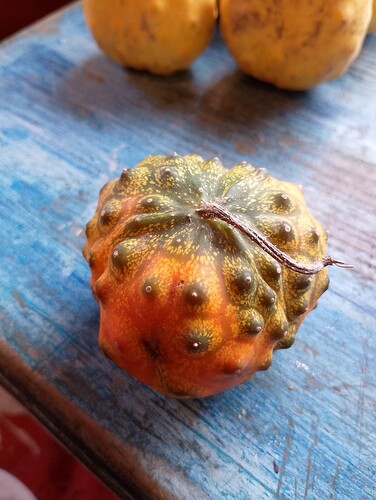Winter squash taste selection eventually summarized here, with watermelon and melon selection summarized also in next post under this one: Direct seed exchange among EU members 2024-2025 - #21 by ThomasPicard
Kiwano selection. Done with fruits around 15th of november, i.e. one to two months post harvest.
There was about 20 square meters of kiwanos, 4 plants per square meter (high density to make more crossings), first selection on vigor (elimination of 80-90% of the less vigorous direct sown kiwanos), and then the harvest was about 40kgs, i.e. 2kg/m2. This yield could be much bigger in better soil and/or with longer growing season.
Grex made out of originally 3 strains: one round all yellow (200-250grams), one oval medium sized (300gr), one oval long sized (350gr)
Appeared intermediary phenotypes since crossings :
I first took good looking fruits of each appearing phenotype:
Then cut them in 2:
Eventually I selected for sugar content, using a refractometer as it appeared that the more sugar content the best the taste was - sugar content being the most limiting factor for kiwano use and acceptation. So the high brix level correlated perfectly with “good taste”.
And so I kept for seeds those with the higher brix level in each category (namely a level of BRIX of 6 for most, apart from the 5,5 of the “giant cross”: 420grams):
After drying I have kept seeds of these best kiwanos in each category in different zip bags. So I have 6 lots (+ a lot of the random early ones)
Examples before seed extraction and drying:
Improvements and questions for next year:
-
Yield estimation was impossible due to high planting density… Everything was intertwinned!!! Next year I will interplant on all sides with other crops to be able to estimate and select high yields on top of good taste, i.e. sugar content.
-
I still don’t have a clear understanding of how kiwano stores and how and if I should select on storing “behavior” : nearly 3 months after this selection I am still eating some which were harvested green at the same time with these others in pictures… My feeling is that even if the green ones mature, turning yellow-orange, the best are eaten at harvest, when they are already yellow-orange.
-
also it’s a quite late fruiting species, so I could select on earliness.
-
I wonder if sugary content is very different between individual plants or is it mostly a maturity thing per fruit - as all “best fruits” were all at 6 BRIX whatever the phenotype and these high brix level were always correlated with maturity traits of the fruits, ine. skin turned orange-yellow.
-
one thing I have confirmed is that if the inner flesh was pale green the kiwano were low in sugar. However intense green did not correlate always with the highest brix rate within each phenotype.
In summary, selection for 2026 could be a mix of these criteria :
- precocity
- high sugar content (brix 6)
- high yield
That maintaining a diversity of appearant phenotypes, as a way to keep diversity.
Then, I am still thinking about bringing in more diversity from landraces of around the world. See that post for example. This document assesses the diversity in a group of different Kenyan landraces :
Agro-morphological_characterization_of_horned_melo.pdf (1019.5 KB)
And those to get some overviews from over angles:
35.Micu1_D.pdf (295.4 KB)
Kiwano_Cucumis_metuliferus_E_Meyer_Ex_Naudin_respo.pdf (823.3 KB)
PlantBreeding-2024-Sebati-AfricanHornedMelonCucumismetuliferusClimateResilientCropandGeneDonorinthe.pdf (10.0 MB)
Quantitative_and_Qualitative_Production_of_Species.pdf (632.9 KB)
Immunological_Activity_and_Gut_Microbiota_Modulati.pdf (9.0 MB)










